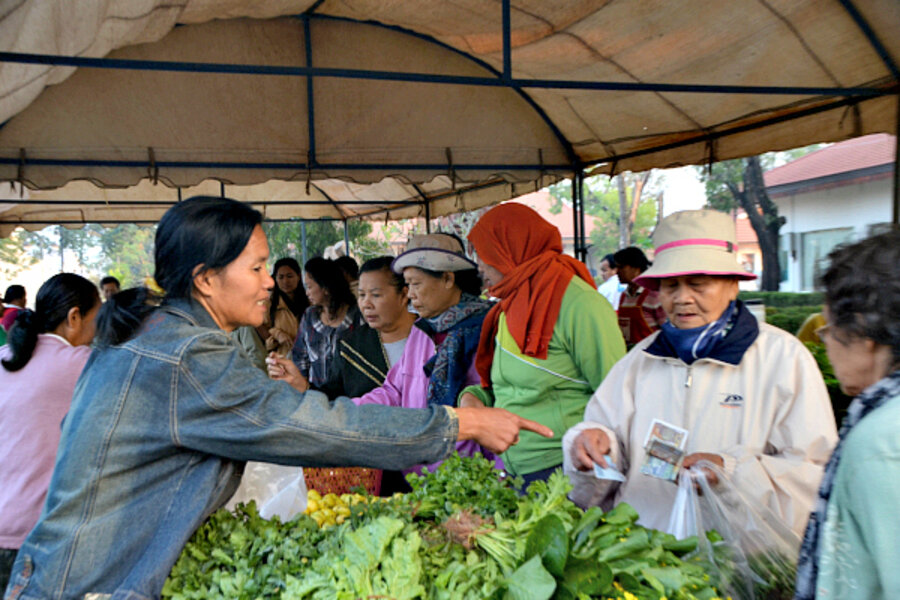Organic farming buds in Laos
| Vientiane, Laos
Every Wednesday, Sengphachan Phommaxay wakes at 4 a.m. and heads across town to the That Luang market in Vientiane, the capital of Laos.
There she meets a truckload of papaya, onions, pumpkins, and more dispatched that morning from the 32-acre family farm 20 miles outside Vientiane in the green, sun-dappled countryside near the Mekong River.
As the sun comes up and orange-clad monks plod barefoot around the funereal Vientiane streets seeking alms, the 23-year-old business student at the Lao American College gets in some hands-on practice for life after graduation, selling the family's produce at Vientiane's main organic market.
“10,000 kip for one kilo,” or $1.25 for just over two pounds, Ms. Sengphachan says, when asked how much the papaya costs. She expects to clear her stall by mid-morning, when the market winds down, but concedes that organic vegetables and fruits are a new thing for many Laotians.
“The population that takes organic vegetables is not that much, and the group that grows [organic produce] is not so big,” she says.
“The taste [of organic foods] is different, better. If you are used to eating organic vegetables, you will notice the difference,” says Sonethong Syhalath, who detours for some pumpkin and onion shopping while out for her early morning exercise. “The price is more expensive, but for the extra time it keeps and for the health it is worth [it] to pay more,” she explains.
One reason organic foods are more expensive is the extra work needed to get the vegetables from farm to market.
“The process and the difficulty is more than with ordinary vegetables, where you use pesticide, so that's why many people are not ready to turn to this farming,” says Sengphachan, handing Ms. Sonethong her change.
Around three-quarters of Laos' 6.5 million people live off the land, with agriculture making up about 25 percent of the country's $19.5 billion GDP (numbers adjusted for for purchasing power parity). The Laotian economy is small, about half the size of Cambodia's, and miniscule compared with Thailand's $662 billion or Vietnam's $325 billion GDPs.
Laos' main export earnings, and much of the country's recent 7 to 8 percent growth, come from mining and hydropower, industries that do not provide many jobs. Farming is expected to be the main employer for Laotians for the foreseeable future.
Laos is a one-party state, governed by the Communist Party, meaning that there is scant recourse for people to push for a change in economic policies that might benefit the wider population. Laos' restrictions on freedom of speech do not usually prompt much international criticism. But the disappearance a year ago of Sombath Somphone, a well-known activist who lobbied for the rights of Laos' rural poor, has drawn fire, with foreign governments criticizing Laos for not doing enough to help find the missing man.
Much of the agriculture here is subsistence, so boosting incomes in the countryside means selling more value-added crops, such as organic fruits and vegetables. But as the only landlocked country in Southeast Asia, Laos faces additional costs in getting goods to markets overseas.
For farmers further inland, away from the border, those costs are raised by Laos' relatively primitive infrastructure.
“The roads in Laos need to be improved and developed," says Somphone Phasanvath, deputy head of the Lao Freight Forwarder company, which, as the name suggests, makes a living by helping companies forward goods from, say, Bangkok, Thailand, to Hanoi, Vietnam, a road trip that involves crossing Laos.
The Asian Development Bank, based in Manila, The Philippines, is “helping promote organic vegetable production” in Laos and Thailand, according to a paper by Rattanatay Luanglatbandith, an economist at the bank. With organic food consumption increasing five-fold in the last six years in Thailand, Laos has “enormous cross-border trade opportunities,” the bank says.
According to an October report by Transparency Market Research, the global demand for organic food and drink could jump from $70.7 billion in 2012 to $187.85 billion in 2019. But for farmers in Laos to get a foothold in bigger, often protected Western markets, the country's distance to a port presents an added burden.
Loumkham Vongsay owns a vegetable-processing factory near the Mekong River, about an hour's drive from Vientiane. It's another 20 minutes from the capital to the Laos-Thailand border. He buys organic corn from local farmers, which he processes before sending by road across the border to Thailand and on to Laem Chabang port, where the corn is shipped to buyers in Germany and Britain, where it appears, branded as organic, on supermarket shelves.
He could not export to Europe, however, without Laos being included in the European Union's preferential trade scheme for poor-country exporters.
“It costs around 50 percent more to send a container of corn from here to the port, compared with someone sending from the Thai side of the border,” he explains.
• Sengphachan Phommaxay and Sonethong Syhalath are pseudonyms. Both women asked that their real names not be used.






